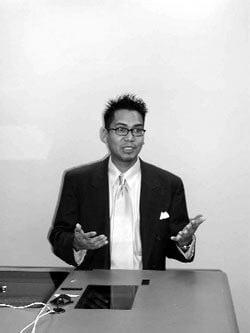Task Force, Asians groups team up on groundbreaking report aimed at dispelling invisibility
Americans of Asian and Pacific Island descent are among the fastest growing minority groups in the nation and among them an increasing number of lesbian, gay, bisexual, and transgendered (LGBT) people are coming out of the closet.
Nevertheless, say community activists, Asian and Pacific Islanders living in the United States, even in major metropolitan area like New York City, still confront issues of cultural isolation and racist stereotyping, even within the queer community.
It is not news that after the terrorist attacks on September 11, 2001, immigrants, particularly those from South Asia (along with, of course, those from the Middle East) came under increased governmental scrutiny, in yet another example of how queer Asian immigrants must strive at times more persistently than their American counterparts to gain mainstream acceptance.
In an effort to break the bubble of invisibility surrounding many queer Asians, the Gay Asian & Pacific Islander Men of New York (GAPIMNY), a local advocacy group, and the Policy Institute of the National Gay and Lesbian Task Force (NGLTF) recently co-sponsored a groundbreaking study, entitled “Asian Pacific American Lesbian, Gay, Bisexual & Transgender People: A Community Portrait.”
The research is the result of a landmark gathering of the New York’s queer Asian and Pacific Islander community held at New York University last March.
The study consisted of 124 participants drawn from the conference’s more than 400 attendees. Half of the participants were from New York City, with the other half saying they live elsewhere on the East Coast or on the West Coast. Sixty-one percent of respondents said that English was their first language, with Cantonese or Mandarin, for Chinese-born, or Tagalog, for Filipino-born, being the predominant native tongues. Nearly a dozen ethnicities were represented in the sample, including Chinese, Filipino and Asian Indian. Smaller numbers of Japanese, Korean and Vietnamese respondents also participated.
Fifty-four percent of the participants were male, 40 percent female, and five percent identified as transgendered. Forty-three percent of respondents self-identified as gay, while 13 percent identified as lesbians, with seven percent saying they were bisexuals.
The report, which marks the first phase of an ongoing, groundbreaking study of the nation’s queers of Asian and Pacific Islander ancestry, revealed that respondents indicated alarmingly high rates of discrimination and harassment, in various sectors of society from the workplace to schools. The study’s authors refer to “dual marginalization,” or being victimized for one’s race and sexual orientation, as a major hurdle for many Asian queers to surmount in their coming-out process.
The project, co-directed by Alain Dang and Mandy Hu, is based on an analysis of survey data from the first phase of what will be the largest multi-gender sample of queer Asians and Pacific Islanders people residing in the U.S.
The Task Force disclosed the results of the report on February 8 at a press conference held at its New York headquarters.
One of the study’s main findings is that 82 percent of respondents reported experiencing discrimination based on their sexual orientation, while the same percentage had experienced discrimination based on their race or ethnicity.
During a follow-up press conference, Glenn D. Magpantay, an official with GAPIMNY, contended that the study was undertaken to bring issues of Asian queers to “the national floor,” in an ongoing effort to render statistics about his community comprehensive to Americans of every stripe.
Other such studies of queer Asians have focused on HIV prevention efforts among men with little research done on women, transgendered Asians, youth or those LGBT people from South Asian nations like India, Pakistan and Bangladesh.
When asked precisely what measures would be taken to counteract the racism and homophobia revealed by the survey, Magpantay emphasized the necessity of organizing LGBT equity efforts in different languages and protecting immigrants not acclimated to American society. Not surprisingly, the issue with which the survey participants were most concerned involved federal immigration regulations.
After September 11, many South Asian immigrants complained about being unfairly targeted and detained by law enforcement authorities. As a result, many LGBT South Asian groups have mounted organizing drives, but they have not had an opportunity to come together beyond local communities.
A similar study conducted by the Asian American Federation of New York (AAFNY) and released on January 11, made use of data compiled in the 2000 Census to give a realistic number of Asian same-sex households.
MCC’s Rev. Pat Bumgardner marries four couples in protest of Bloomberg legal appeal
gaycitynews.com


































